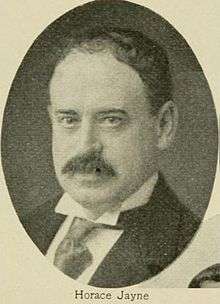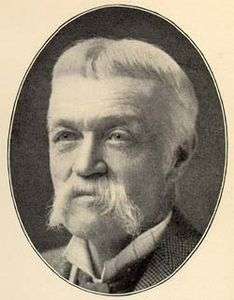Horace Jayne House
Horace Jayne House (1895) is an architecturally significant building designed by architect Frank Furness in Philadelphia, Pennsylvania. It is located at the southwest corner of 19th and Delancey Streets, about a block south of Rittenhouse Square.
Horace Jayne House | |
Horace Jayne House, February 2010 | |
   | |
| Location | 320 S. 19th St., Philadelphia, Pennsylvania |
|---|---|
| Coordinates | 39°56′52″N 75°10′25″W |
| Area | 0.1 acres (0.040 ha) |
| Built | 1895 |
| Architect | Furness, Evans & Co. |
| Architectural style | Colonial Revival |
| NRHP reference No. | 82003810[1] |
| Added to NRHP | July 22, 1982 |
The Horace Jayne House was added to the National Register of Historic Places in 1982.[1]
History
The house was built as the residence and office of Dr. Horace Jayne (1859–1913) and his wife Caroline Furness Jayne (1873–1909), and was completed in 1895.[2] Dr. Jayne was a zoologist and professor at the University of Pennsylvania. Mrs. Jayne, the architect's niece, was an ethnologist and an authority on string figures. Following her death at age 36, Dr. Jayne and their children – Kate Furness Jayne (1895–1940)[3] and Horace H. F. Jayne (1898–1975)[4] – moved year-round to "Sub Rosa," their summer house on the Wallingford, Pennsylvania property of her father, Horace Howard Furness.[5]:321
The city house was acquired by department-store heir Jacob Lit of Lit Brothers about 1928, who probably added the radiator covers of frolicking greyhounds by sculptor William Hunt Diederich.[6] It was converted into a synagogue in the 1940s, and served as headquarters for the Heart Association of Southeastern Pennsylvania from the 1950s to the 1980s.[2] The building was renovated in the late 1980s into the law offices of Anapol, Schwartz, Weiss & Schwartz.[7] It was sold in 2007, and underwent a 2-year restoration by John Milner, Architects.[8] It is now, again, a single-family residence.[9]
Many of Furness's grandest Philadelphia houses of the 1880s and 1890s were built near or fronting on Rittenhouse Square.[5]:230–31, 276, 282, 309 These included the William W. Frazier house (1881-82, demolished), at the southwest corner of 18th & Rittenhouse Square Streets;[10] the George B. Preston house (1881-83, demolished), at the northeast corner of 22nd & Walnut Streets;[11] the Thomas A. Scott house (1887-88, demolished), at the southeast corner of 19th & Rittenhouse Square Streets;[12] the Alexander J. Cassatt house (1888, demolished), at 202 South 19th Street (Rittenhouse Square West);[13] and the Thomas A. Reilly house (1891-92), at 1804 Rittenhouse Square Street.[14] Of these, only the Reilly house and the Jayne house survive.
Design
The eclectic building's design is highly unusual, and its volumes are articulated on the exterior. The facade is divided into two halves; a 3-1/2 story southern section that contained Dr. Jayne's offices – a ground-floor waiting room and an examination room above – and a 2-1/2 story northern section that contained the high-ceilinged formal rooms. The floor levels coincide on the upper stories. The main entrance is off-center in a slightly projected section, with an oval window and a bracket-supported Juliet balcony above. The Colonial Revival-detailed exterior is composed of red English sandstone and brick, and features terra cotta reliefs by sculptor Karl Bitter on the east, north and west façades and the pedimented dormers.[2] Bitter also modeled the reliefs for Furness & Evans's contemporaneous Broad Street Station (1893-94).[15]
The interior is remarkable. The formal rooms are located a half-story above the entrance. The 2-story central hall features a grand staircase on the south wall that wraps around the fireplace, a hanging gallery (suspended from the ceiling by iron rods) that traces the other three walls, and an intricate leaded glass skylight.[5]:319–20 A favorite visual pun of Furness's was to place a window above a fireplace, splitting the flues into the walls flanking it—as he did at Jefferson Medical College (1875-77) and the parish hall of First Unitarian Church of Philadelphia (1883-86).[16] With the Jayne house's central hall he took his punning to an extreme, placing a curved balcony and a horseshoe-shaped seating area above the fireplace (accessed from an intermediate landing behind), and splitting the flues into piers that merged to form a soaring triumphal arch.[17]
 Dr. Horace Jayne, 1899
Dr. Horace Jayne, 1899 Architect Frank Furness, 1901
Architect Frank Furness, 1901
References
- "National Register Information System". National Register of Historic Places. National Park Service. July 9, 2010.
- "National Historic Landmarks & National Register of Historic Places in Pennsylvania" (Searchable database). CRGIS: Cultural Resources Geographic Information System. Note: This includes George E. Thomas (February 1982). "National Register of Historic Places Inventory Nomination Form: Horace Jayne House" (PDF). Retrieved 2012-06-16.
- Kate Furness Jayne Duer, from Find-A-Grave.
- Horace Howard Jayne, from Find-A-Grave.
- George E. Thomas, et al., Frank Furness: The Complete Works (Princeton University Press, revised 1996).
- Preservation Matters (Spring 2011), Preservation Alliance of Philadelphia newsletter.
- Terrence G. List, "The Philadelphia of Frank Furness," The Philadelphia Inquirer, November 8, 1989.
- Will Holloway, "Landmark Restoration," from Palladio Awards.
- "House Party," The Philadelphia Inquirer, October 20, 2010.
- William W. Frazier house, from FrankFurness.org.
- George B. Preston house, from Bryn Mawr College.
- Thomas A. Scott house, from Furnesque.
- Rogers-Cassatt House, from Historic American Buildings Survey.
- Thomas A. Reilly house, from Pinterest.
- James F. O'Gorman, et al., The Architecture of Frank Furness (Philadelphia Museum of Art, 1973), pp. 180-81, figs. 33-1 & 33-4.
- James F. O'Gorman, et al., The Architecture of Frank Furness (Philadelphia Museum of Art, 1973), pp. 48, 148-49, figs. 24-8 & 24-10.
- Photographs of the interior, from James F. O'Gorman, et al., The Architecture of Frank Furness (Philadelphia Museum of Art, 1973), pp. 188-90.

